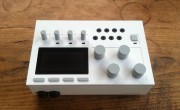Who can say they have never turned to the internet for some temporary entertainment? Even more so, who can say in looking for said temporary entertainment, the answer has never been found through humorous or odd animal videos on YouTube – Dogs, cats, birds, and so on either talking, singing, or performing some humanistic feat that seems initially unbelievable until someone presses “play.” Well, with this in mind, the idea that the common, everyday goldfish might turn out to be a harp virtuoso can’t be a farfetched tale, right?
In a few words: Yes and no.
Hong Kong artist Henry Chu, brought both fish and music together for a piece he dubbed the “Fish Harp.” Part of an exhibition called “Musique Plastique,” put on by the Librairie Galerie in Hong Kong, which is part of the Agnès B. Group. The combined visual art and musical component of Chu’s project fit perfectly into the exhibition’s objective, described as:
understand[ing] the projects of the 18 artist-musicians (or musician-artists) from a double point of view – visual and musical. This way we can better see their impact, better measure their diversity and individuality, and better understand what separates them from other contemporary art and music scenes.
Where there is a simultaneous statement of real and exaggerated with Chu’s project is in the fish themselves versus the music they create. Chu actually created the fish, which are artificial simulations thereof shown on a tabletop screen. The sound heard in the exhibition “played” by the fish is real and activated by the motion of the fish “swimming” underneath a set of clear glasses that emit different tones, depending on which glass the fish swim past.
It should also be explained that how one views the exhibition is meant to enhance the sense of realism and natural aesthetic presented when one watches fish swimming below the water in a live setting. As reported on Co.design, Chu’s artistic vision was to “[extend] a 2-D screen into 3-D space…reflecting the light of a flat display through a collection of transparent objects to create some sort of a mirage.”
The decision to use fish as the medium playing the music came out of inspiration Chu gained from a Chinese expression, that when generally translated, says, “like flowers in the mirror and the moon in the water.” A proverb referencing illusion and taking into account the similarity of the words “moon” and “fish” in Chinese, this was the line of thinking that led to fish as the chosen element. (That and fish were more physically feasible than the moon, according to Co.design)
Further blending of the artistic and musical comes into play through the sight of the fish in motion and the shape of the glasses –both circular– which then creates tones akin to those of the glass harp. It is almost as if no part of Chu’s piece is without a primary or, at the very least, supporting purpose to the overall theme intended in Musique Plastique. The only aspect that seems less calculated, (though if this is meant to evoke feelings of “real fish” that can be debated), is the lack of tonal organization that is almost immediately noticeable if one listens to the fish for more than a few seconds. There is no pattern; no synchronized school of fish hitting harmonious notes and covering familiar jingles.
Perhaps though, this is the perfect place for Chu’s artistic planning to stop. If the fish were indeed programmed to move in ways that would cause them to emulate familiar songs, Chu’s sophisticated art exhibition would become just another semi-unbelievable “YouTube animal video.”
Fish harp finishes out its showing in Hong Kong through January 12.
Below is a short clip of the Fish Harp in play:
Kira is an old school music nerd with a love for all things creative; always searching for music’s common ground. She graduated with an M.A. in Performing Arts Administration from New York University. Drop her a tweet @shadowmelody1



![[Interview] With Their Stunning Crystallized Volcano, Krewella Hopes to Blow Fans’ Minds](http://www.soundctrl.com/blog/wp-content/uploads/2013/09/Identity_Set-180x110.jpg)

![[Interview] Matt Loszak, Founder of JamCam](http://www.soundctrl.com/blog/wp-content/uploads/2013/10/Slide11-50x50.jpg)









Comments are closed.